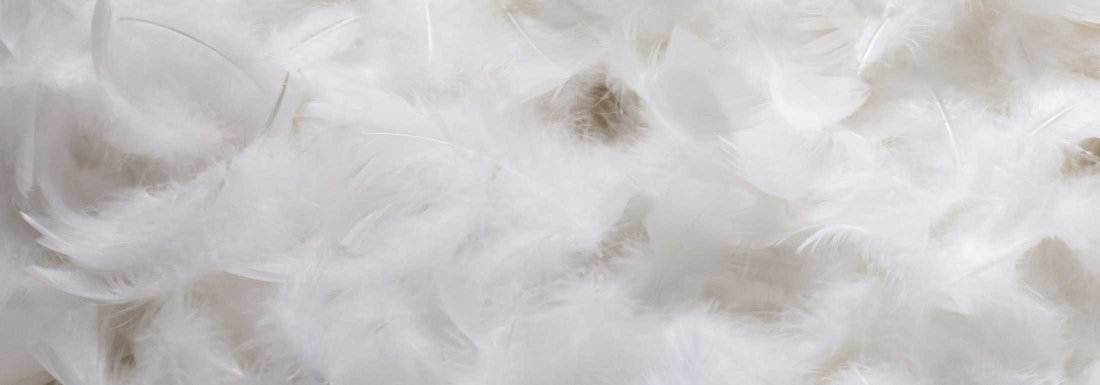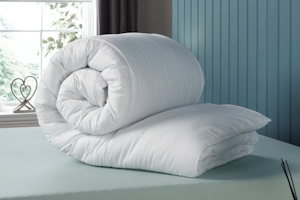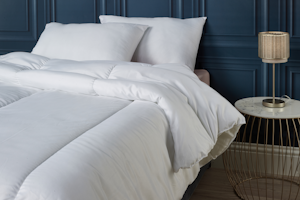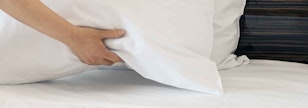20 Mar 2025

What is Goose Down? Is it Better than Feather?
17 Feb 2023
Historically, geese plumage has been used to create the highest-quality duvets and pillows on the market. No synthetic material has yet to match the natural properties that goose down and feathers can provide as fillings. However, when compared with each other, these two types of plumage are not entirely equal; serving different original purposes, goose down and goose feathers have different structures, and therefore offer different properties as bedding fillings.
Goose down is the soft, fluffy, yet highly-insulating layer that lies beneath the geeses’ outermost coat of feathers. While they primarily use their outer feathers for protection, down is the heat-retentive layer that geese use to keep themselves warm. Goose down is essentially a higher-end and more luxurious filling than goose feathers; as a filling, down is superior to feathers in numerous respects, from its insulating properties, to its weight, breathability and comfort.
What is Goose Down?
Goose down is a type of luxury natural filling made from the downy undercoat of geese. On geese, and other types of waterfowl, the down layer lies beneath their outer protective coat of feathers; it is a soft, fluffy layer of heat-trapping feather clusters that act as insulation for these birds.
The insulating properties of goose down are due to the unique structure of the down feathers. Each individual feather is a spherical cluster of fine, soft filaments, with these filaments branching out in different directions. Between the down clusters, the filaments create thousands of air pockets that effectively trap heat against the geese’s bodies. This creates a warm, insulating layer that keeps the geese warm even when external temperatures drop significantly low; such conditions are typical of Hungary and Siberia where much of the world’s down-producing fowl originate.
In geese, this heat-retaining process is known as ‘lofting’. Technology has yet to be able to synthesize the lofting process and unique properties that down offers as a filling; no existing synthetic filling can provide the same degree of quality as goose down. This is because, in spite of its unparalleled heat retention, down is also exceptionally soft, lightweight, durable, and flexible. Down is therefore considered the utmost luxurious high-end type of filling available, particularly for bedding like duvets and pillows.
How is Down Different to Feathers?
Down and feathers are taken from different parts of the bird, and so they also differ in their structure and properties as a filling.
As we’ve already discussed, down comes from a separate layer that lies beneath the outermost coat of the birds’ feathers; it is only found on the chest or belly of the birds as these are their parts that require the most insulation. Feathers are instead taken from the birds’ superficial plumage, which primarily acts as a protective barrier rather than an insulating layer.
Because of these differences in their original purpose, feathers and down differ in their structure and insulating properties. Down feathers are thicker and much more heat-retentive than regular feathers; also, unlike regular feathers, down feathers lack a stem, instead being small round clusters of soft downy filaments. Despite their superior heat-retentive properties, down feathers are lighter in weight than regular feathers.
Is Goose Down Better than Goose Feather?
Yes, as a filling, goose down is better than goose feather in several respects. In short, goose down is a more insulating and longer-lasting filling than goose feather, while also being fluffier and more breathable.
Compared to goose down, goose feathers have somewhat poorer heat-retentive properties due to the differences in these fillings’ structures. Regular goose feathers are unable to form the tight insulated pockets of air that down feathers naturally create; this limits the feathers’ ability to hold onto heat when being used as a bedding filling. Considering that the original primary purpose of goose down is to retain heat, it naturally surpasses feathers in this regard.
Furthermore, goose down also creates a softer, fluffier, and more durable filling than goose feathers. Like we’ve mentioned, regular feathers have a stem or ‘quill’ running the length of each individual feather. These quills are hard and inflexible, which results in a less comfortable filling for pillows and duvets; they’re also prone to snapping when the filling is compressed during sleep, which consequently shortens the lifespan of the bedding. Goose down, on the other hand, lacks any form of hard quill; it is therefore much softer and durable against wear and tear than its feather counterparts.
Still, that isn’t to say that you should write off goose feathers as a filling. Due to its superior qualities, down tends to be more expensive than feathers; this may put products containing 100% down outside of your budget. You can instead opt for combined products like our Luxury Goose Feather & Down Pillow and Luxury Goose Feather & Down 13.5 Tog Duvet; these products have the ideal balance of feather and down, providing optimal comfort and heat-retention at a more affordable price.
Is Goose Down Better than Duck Down?
Yes, goose down is superior to duck down as a bedding filling. Being birds of a similar origin, the feathers and down that geese and ducks produce are very alike in structure; even so, there are some qualities that set them apart from one another.
In essence, whether it’s taken from a goose or a duck, down has the same basic structure; as per our explanation earlier in the article, down feathers of all origins are fluffy clusters of soft, directionally-variating filaments. However, goose down and duck down differ somewhat in their texture. The filaments in goose down tend to be on the larger and thicker side, while still being lightweight. In duck down, the filaments are smaller, but they’re also heavier and more dense. These properties enable goose down to create bedding that is both more insulating and more breathable than duck down.
Another factor that influences the quality of the down taken from these different birds is the maturity of their feathers. Among domestic birds, geese are the only species from which it’s possible to pluck multiple times during their lifetime; this means that the down feathers from geese are typically more mature than those plucked from ducks. Therefore, as mature feathers from older birds are generally of higher quality, goose down tends to create a better quality filling.
An additional difference between goose down and duck down is the odour that these fillings give off. It’s expected for any type of natural feather or down filling to give off somewhat of an odour; waterfowl protect their feathers and skin by secreting sebum from their sebaceous glands, which gives their feathers this distinctive scent. Compared to geese, ducks tend to produce much more sebum, and consequently, their filling has a stronger smell. So, this is just another reason why goose down is better than duck down, particularly for those with sensitive noses.


